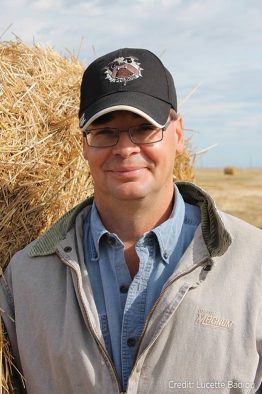What better way to learn about blackleg?
Gary Peng’s study into fungicides for blackleg was featured on page 13 of the 2015 Canola Digest Science Edition. Find it at canoladigest.ca.
University of Manitoba professor and plant pathologist Dilantha Fernando was telling his agriculture class three years ago about a blackleg project he was about to start. It included a survey of fields across the Prairies to see what blackleg pathotypes were present and how pathotypes changed over time.
After class, a student came up to him and said her dad may be interested. The student was Lucette Badiou from Notre Dame de Lourdes, Man., and her dad, Andre, was starting to see more blackleg on their canola.

“A couple of decades ago my dad and I had to quit growing canola because of severe blackleg in Westar,” Andre says. When blackleg-resistant varieties came along, they got back into canola. In 2014, when he saw blackleg return in a big way, Andre thought, “Oh no, here it comes again.”
Fernando sent out two assistants on the project, including a doctoral student who collected the samples and gave Andre and Lucette a few pointers on blackleg management.
The Badious usually rotated canola varieties, but in one field they had grown a Roundup Ready variety in 2012 and the same variety again in 2014. The canola also lodged fairly badly. It seemed to have blackleg anywhere stems cracked from lodging, Andre says. A survey found blackleg on 95 per cent of the plants.
The following year, the assistants surveyed a Badiou canola field seeded to a different herbicide system. Andre had also sprayed it with a fungicide. Blackleg incidence on that field was only five per cent.
Badiou is one of 75 or so farmers involved in the five-year project funded through the federal government’s Growing Forward 2. Fernando is working with Gary Peng, research scientist with Agriculture and Agri-Food Canada (AAFC) in Saskatoon, and Ralph Lange, plant pathologist with Alberta Innovates, to investigate changes in blackleg populations and how that affects genetic resistance in canola varieties. The goal is to develop a durable blackleg resistance stewardship plan.
So far, the researchers have seen changes in the virulence of L. maculans, the more common blackleg-causing pathogen in Western Canada. Specifically, changes in the pathogen population AvrLm3 have led to the breakdown of the canola resistance gene Rlm3 in some fields. Rlm3 is the most common resistance gene in Canadian
canola varieties.
The study should show how crop rotation and other agronomic practices affect the rate of pathogen adaptation as well as the relative durability of different resistant sources. Increased knowledge of L. maculans pathotype diversity
could allow seed breeders to improve their disease resistance package and allow farmers to select varieties with resistance to suit the pathotypes present in their fields.
A system where growers can test which pathotypes are present in a field and then choose a variety that will be resistant to those pathotypes is close, and would be a big step forward for blackleg stewardship in Canada, Fernando says.
Meanwhile, the project has already inspired some important management changes on the Badiou farm. They will now use a consistent three-year rotation, growing canola, soybeans and wheat. And they will apply a blackleg-targeted fungicide at the two- to four-leaf stage of the crop. It will go on in a tank mix with the first in-crop herbicide application.
Fernando notes that the value of fungicides remains questionable in most situations. Recent research led by Gary Peng with AAFC concluded that fungicide applications may help only when the variety is susceptible to blackleg and disease risk is high.




